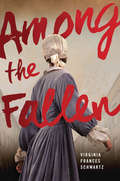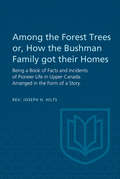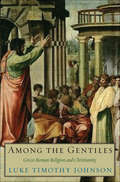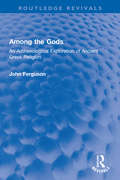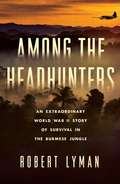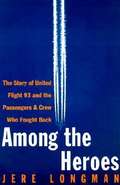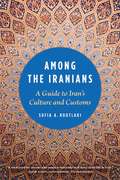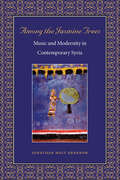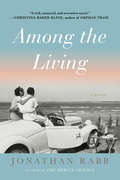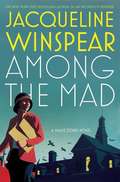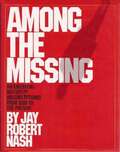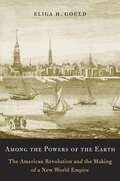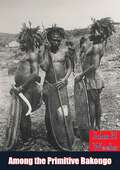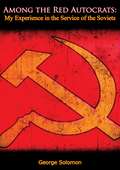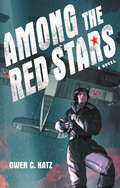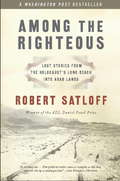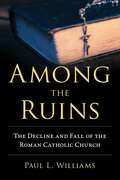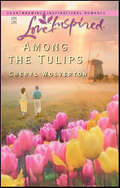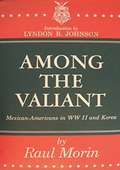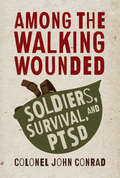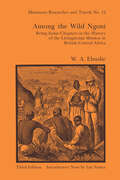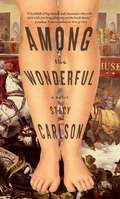- Table View
- List View
Among the Fallen
by Virginia Frances SchwartzSixteen-year-old Orpha is imprisoned for crimes she did not commit, and harboring a terrible secret about her abuser, but an unusual invitation from Charles Dickens to live in a home for fallen women offers hope.From the infamous Tothill prison, Orpha is haunted by recurring flashbacks of sexual abuse, neglect, exploitation, and the horrors of a Victorian workhouse, but she refuses to be crushed. Her heartbreaking yet inspiring story tells of the resilience and courage needed to make a new life for herself against all odds with the support of the amazing women of Urania cottage and the help of famous author Charles Dickens. Fans of Laurie Halse Anderson's Fever 1793, Margaret Atwood's Alias Grace, and Katherine Paterson's Lyddie will enjoy this riveting historical fiction title. Schwartz's powerful prose speaks to the terrible things Orpha has endured yet celebrates the emotional and intellectual powers of young women.
Among the Forest Trees or, A Book of Facts and Incidents of Pioneer Life in Upper Canada: Arranged in the Form of a Story
by Douglas Lochhead Joseph HiltsA book of pioneer life in Upper Canada, arranged in the form of a story. The author spent five-sevenths of his life among the pioneer settlers of Western Canada. The incidents in the story are taken from the active life of the pioneers of Western Ontario, among whom the author grew up. A keen observer, the reverend author has been able to produce a faithful record of the hardships, trials and successes of the hardy pioneers of the Niagara district, and all that magnificent country lying between the Niagara River and Lake Huron and Georgia Bay. It is needless to say, therefore, that the book possesses much historic value as a picture of Canadian life in the early days of this western peninsula. The book is one which will be read with deep interest by those of the old pioneers who remain, and ought to become one of the household treasures of the descendants of those pioneers for many generations.
Among the Gentiles: Greco-roman Religion and Christianity
by Luke Timothy JohnsonThe question of Christianity's relation to the other religions of the world is more pertinent and difficult today than ever before. While Christianity's historical failure to appreciate or actively engage Judaism is notorious, Christianity's even more shoddy record with respect to "pagan" religions is less understood. Christians have inherited a virtually unanimous theological tradition that thinks of paganism in terms of demonic possession, and of Christian missions as a rescue operation that saves pagans from inherently evil practices. In undertaking this fresh inquiry into early Christianity and Greco-Roman paganism, Luke Timothy Johnson begins with a broad definition of religion as a way of life organized around convictions and experiences concerning ultimate power. In the tradition of William James'sVariety of Religious Experience, he identifies four distinct ways of being religious: religion as participation in benefits, as moral transformation, as transcending the world, and as stabilizing the world. Using these criteria as the basis for his exploration of Christianity and paganism, Johnson finds multiple points of similarity in religious sensibility. Christianity's failure to adequately come to grips with its first pagan neighbors, Johnson asserts, inhibits any effort to engage positively with adherents of various world religions. This thoughtful and passionate study should help break down the walls between Christianity and other religious traditions.
Among the Gods (Chronicles of the Kings #5)
by Lynn AustinFleeing King Manasseh's tyranny, Joshua leads the faithful remnant to their new home in Egypt. But as years pass, Joshua's desire for vengeance becomes an obsession. Blinded by hatred, he makes rash decisions, placing his loved ones in jeopardy. Amid Joshua's turmoil comes an unexpected awakening of love--a love that burns so intensely it draws him from the dark inner seclusion where he often retreats. But what will it take for him to grasp the great love his Heavenly Father has for him. . . and for the chosen people of Judah? (Chronicles of the King Book 5)
Among the Gods: An Archaeological Exploration of Ancient Greek Religion (Routledge Revivals)
by John FergusonFirst published in 1989, Among the Gods uses archaeological evidence to explore ancient Greek religion. The book analyses cult-statues and inscriptions to provide a detailed discussion of gods and goddesses, the priesthood, and healing sanctuaries. In doing so, it highlights the external, formal nature of religious practice in ancient Greece, such as pilgrimages, offerings, and hallowed sites. Archaeological records are used to examine both the theory and practice of ancient Greek religion, and to provide context to a variety of Greek myths and Greek literature. Among the Gods will appeal to those with an interest in religious history, archaeological history, and Classical history.
Among the Headhunters: An Extraordinary World War II Story of Survival in the Burmese Jungle
by Robert LymanFlying the notorious "Hump" route between India and China in 1943, a twin-engine plane suffered mechanical failure and crashed in a dense mountain jungle, deep within Japanese-held territory. Among the passengers and crew were celebrated CBS journalist Eric Sevareid, an OSS operative who was also a Soviet double agent, and General Joseph "Vinegar Joe" Stilwell's personal political adviser. Against the odds, all but one of the twenty-one people aboard the doomed aircraft survived-it remains the largest civilian evacuation of an aircraft by parachute. But they fell from the frying pan into the fire.Disentangling themselves from their parachutes, the shocked survivors discovered that they had arrived in wild country dominated by a tribe with a special reason to hate white men. The Nagas were notorious headhunters who routinely practiced slavery and human sacrifice, their specialty being the removal of enemy heads. Japanese soldiers lay close by, too, with their own brand of hatred for Americans.Among the Headhunters tells-for the first time-the incredible true story of the adventures of these men among the Naga warriors, their sustenance from the air by the USAAF, and their ultimate rescue. It is also a story of two very different worlds colliding-young Americans, exuberant apostles of their country's vast industrial democracy, coming face-to-face with the Naga, an ancient tribe determined to preserve its local power based on headhunting and slaving.
Among the Heros
by Jerry LongmanON SEPTEMBER 11, 2001, passengers were not encouraged to assist the crew in the rare case of an airplane hijacking. They were actively discouraged. That all changed with the brave insurrection of the passengers and crew members aboard United Flight 93.
Among the Iranians: A Guide to Iran's Culture and Customs
by Sofia A. KoutlakiAn indispensable practical guide, Among the Iranians offers insight into Iranian dress, etiquette, and food. Koutlaki explains everything readers need to know about culture and customs by sharing lessons she learned as a foreigner living in Tehran. Readers are challenged to dispel previous judgments of Iran and accept Koutlaki's version of the country-warm, inviting, and rich with tradition.
Among the Jasmine Trees: Music and Modernity in Contemporary Syria (Music Culture)
by Jonathan Holt ShannonHow does a Middle Eastern community create a modern image through its expression of heritage and authenticity? In Among the Jasmine Trees: Music and Modernity in Contemporary Syria, Jonathan H. Shannon investigates expressions of authenticity in Syria's musical culture, which is particularly known for embracing and preserving the Arab musical tradition, and which has seldom been researched in depth by Western scholars. Music plays a key role in the process of self-imaging by virtue of its ability to convey feeling and emotion, and Shannon explores a variety of performance genres, Sufi rituals, song lyrics, melodic modes, and aesthetic criteria. Shannon shows that although the music may evoke the old, the traditional, and the local, these are re-envisioned as signifiers of the modern national profile. A valuable contribution to the study of music and identity and to the ethnomusicology of the modern Middle East, Among the Jasmine Trees details this music and its reception for the first time, offering an original theoretical framework for understanding contemporary Arab culture, music, and society.
Among the Living
by Jonathan RabbA moving novel about a Holocaust survivor's unconventional journey back to a new normal in 1940s Savannah, Georgia. In late summer 1947, thirty-one-year-old Yitzhak Goldah, a camp survivor, arrives in Savannah to live with his only remaining relatives. They are Abe and Pearl Jesler, older, childless, and an integral part of the thriving Jewish community that has been in Georgia since the founding of the colony. There, Yitzhak discovers a fractured world, where Reform and Conservative Jews live separate lives--distinctions, to him, that are meaningless given what he has been through. He further complicates things when, much to the Jeslers' dismay, he falls in love with Eva, a young widow within the Reform community. When a woman from Yitzhak's past suddenly appears--one who is even more shattered than he is--Yitzhak must choose between a dark and tortured familiarity and the promise of a bright new life. Set amid the backdrop of America's postwar south, Among the Living grapples with questions of identity and belonging, and steps beyond the Jewish experience as it situates Yitzhak's story during the last gasp of the Jim Crow era. Yitzhak begins to find echoes of his own experience in the lives of the black family who work for the Jeslers--an affinity he does not share with the Jeslers themselves. This realization both surprises and convinces Yitzhak that his choices are not as clear-cut as he might have thought.
Among the Living and the Dead: A Tale Of Exile And Homecoming On The War Roads Of Europe
by Inara Verzemnieks“Extraordinarily tender and finely wrought.” — Eliza Griswold, author of The Tenth Parallel “It’s long been assumed of the region where my grandmother was born…that at some point each year the dead will come home,” Inara Verzemnieks writes in this exquisite story of war, exile, and reconnection. Her grandmother’s stories recalled one true home: the family farm left behind in Latvia, where, during WWII, her grandmother Livija and her grandmother’s sister, Ausma, were separated. They would not see each other again for more than 50 years. Raised by her grandparents in Washington State, Inara grew up among expatriates, scattering smuggled Latvian sand over the coffins of the dead, singing folk songs about a land she had never visited. When Inara discovers the scarf Livija wore when she left home, in a box of her grandmother’s belongings, this tangible remnant of the past points the way back to the remote village where her family broke apart. There it is said the suspend their exile once a year for a pilgrimage through forests and fields to the homes they left behind. Coming to know Ausma and the trauma of her exile to Siberia under Stalin, Inara pieces together Livija’s survival through years as a refugee. Weaving these two parts of the family story together in spellbinding, lyrical prose, she gives us a profound and cathartic account of loss, survival, resilience, and love.
Among the Mad (Maisie Dobbs #6)
by Jacqueline WinspearIn the thrilling new novel by the New York Times bestselling author of An Incomplete Revenge, Maisie Dobbs must catch a madman before he commits murder on an unimaginable scale. It's Christmas Eve 1931, on the way to see a client, Maisie Dobbs witnesses a man commit suicide on a busy London street. The following day, the prime minister's office receives a letter threatening a massive loss of life if certain demands are not met and the writer mentions Maisie by name. After being questioned and cleared by Detective Chief Superintendent Robert MacFarlane of Scotland Yard's elite Special Branch, she is drawn into MacFarlane's personal fiefdom as a special adviser on the case. Meanwhile, Billy Beale, Maisie's trusted assistant, is once again facing tragedy as his wife, who has never recovered from the death of their young daughter, slips further into melancholia's abyss. Soon Maisie becomes involved in a race against time to find a man who proves he has the knowledge and will to inflict death and destruction on thousands of innocent people. And before this harrowing case is over, Maisie must navigate a darkness not encountered since she was a nurse in wards filled with shell-shocked men. In Among the Mad, Jacqueline Winspear combines a heart-stopping story with a rich evocation of a fascinating period to create her most compelling and satisfying novel yet.
Among the Missing: An Anecdotal History of Missing Persons from 1800 to the Present
by Jay Robert NashThe endless mystery of Amelia Earhart's last flight. The mysterious disappearance of Judge Joseph Force Crater. The vanishing acts of Agatha Christie, Sherwood Anderson and Aimee Semple McPherson. The lost adventurers - Colonel Percy Fawcett, Richard Halliburton, and George Leigh-Mallory. These famous faces and hundreds more make up this fascinating and fact-filled book. Along with the cases that made national and worldwide headlines, there are the exotic stories of infamous or until now obscure missing persons which read like captivating mystery, adventure, and sometimes science fiction tales. There is the case of New York heiress Dorothy Arnold, who vanished forever while crossing Fifth Avenue during a day of shopping. And David Lang, who according to 5 eyewitnesses, evaporated into thin air on a Tennessee country road in 1880. Then there was Arthur Orton, who insisted until his last breath that he was Roger Charles Tichborne, the scion of one of England's oldest families, whose vast holdings brought him a million dollars a year until he mysteriously disappeared with the ship Bella in 1854. The stories of those who returned from the world of the missing are often the most bizarre. The book contains all the elements of high human drama: love, vengeance, avarice, adventure, mystery, violence, sex, and murder.
Among the Powers of the Earth
by Eliga H. GouldFor most Americans, the Revolution’s main achievement is summed up by the phrase “life, liberty, and the pursuit of happiness. ” Yet far from a straightforward attempt to be free of Old World laws and customs, the American founding was also a bid for inclusion in the community of nations as it existed in 1776. America aspired to diplomatic recognition under international law and the authority to become a colonizing power itself. As Eliga Gould shows in this reappraisal of American history, the Revolution was an international transformation of the first importance. To conform to the public law of Europe’s imperial powers, Americans crafted a union nearly as centralized as the one they had overthrown, endured taxes heavier than any they had faced as British colonists, and remained entangled with European Atlantic empires long after the Revolution ended. No factor weighed more heavily on Americans than the legally plural Atlantic where they hoped to build their empire. Gould follows the region’s transfiguration from a fluid periphery with its own rules and norms to a place where people of all descriptions were expected to abide by the laws of Western Europe-“civilized” laws that precluded neither slavery nor the dispossession of Native Americans.
Among the Primitive Bakongo: and other tribes of equatorial Africa, with a description of ... habits, customs & religious beliefs
by John H WeeksAmong the Primitive Bakongo by John H. Weeks offers a vivid and insightful account of life among the Bakongo people of Central Africa, based on the author’s extensive firsthand experiences as a missionary and ethnographer in the late 19th and early 20th centuries. Weeks provides a detailed exploration of Bakongo culture, traditions, and social structures, capturing the essence of their daily lives, beliefs, and customs.The book delves into various aspects of Bakongo society, from their kinship systems and governance to their religious practices and ceremonies. Weeks pays particular attention to the Bakongo’s spiritual worldview, including their use of fetishes, ancestral worship, and rites surrounding life, death, and healing. Through his careful observations, he illuminates how these traditions shaped the community's identity and cohesion.While grounded in the anthropological curiosity of its time, Among the Primitive Bakongo also reflects the broader context of European interactions with African societies during the colonial period. Though written from the perspective of a Western observer, the work offers valuable historical insights into a rich and complex culture that was undergoing significant change.With its blend of ethnographic detail and narrative storytelling, this book remains a fascinating resource for anyone interested in African history, anthropology, or the interplay between tradition and transformation in a rapidly shifting world.
Among the Red Autocrats: My Experience in the Service of the Soviets
by George Solomon Dr Arno C. GaebeleinFirst published in 1935, this is the full and frank account of author George Solomon’s service to the Soviet Government during the Russian Civil War.Solomon, who was named First Secretary to the Commissar for Commerce and Industry, Leonid Borisovich Krasin, in July 1918, provides a detailed record of his time with the Red Autocrats, beginning with assuming his new position and his first meeting with L. B. Krasin in Germany in July of 1918, being welcomed as an enemy in his native Russia in June 1919, to representing the Commission of Administration to take over all the business transactions in Estonia in August 1920 and, finally, arriving in England in June 1921, before his retirement from service on August 1, 1923.
Among the Red Stars
by Gwen C. KatzA suspenseful historical YA debut inspired by the true story of an all-female bomber unit in Russia during World War II.World War II has erupted in Valka’s homeland of Russia, and Valka is determined to help the effort. She’s a pilot—and a good one—so she eagerly joins an all-female bomber regiment. Flying has always meant freedom and exhilaration for Valka, but dropping bombs on German targets is something else entirely. The raids are dangerous, but as Valka watches her fellow pilots putting everything on the line in the face of treachery, she learns the true meaning of bravery. As the war intensifies, though, and those around her fall, Valka must decide how much she is willing to risk to defend the skies she once called home. Inspired by the true story of a famous all-female Russian bomber regiment, Gwen C. Katz weaves a tale of strength and sacrifice, of learning to fight for yourself, and of the perils of a world at war.
Among the Righteous
by Robert SatloffWas there an Arab Schindler? The neverbefore- told story of the Holocaust in the Arab lands of North Africa, and one man's quest to find the truth
Among the Ruins: The Decline and Fall of the Roman Catholic Church
by Paul L. WilliamsThis critical review of the Roman Catholic Church since the pivotal changes initiated in the 1960s by Vatican II paints a disturbing picture of decline and corruption. Dr. Paul L. Williams, a self-professed Tridentine or traditionalist Catholic, traces the various factors that have caused the Church to suffer cataclysmic losses in all aspects of its life and worship in recent decades. Williams illustrates the decline with telling statistics showing the stark difference between the robust number of clergy members, parishes, schools, and active church-going Catholics in 1965 versus the comparatively paltry number today. The author is highly critical of Popes Paul VI, John Paul II, Benedict XVI, and Francis for steering the church so far away from its traditional teachings and for a lack of oversight that allowed corruption to fester. Symptomatic of this failure of leadership are the recent pedophilia scandals, the ongoing financial corruption, a gay prostitution ring inside the Vatican, and criminal investigations of connections between the Holy See and organized crime. This unflinching critique from a devoted, lifelong Catholic is a wakeup call to all Catholics to restore their church to its former levels of moral leadership and influence.
Among the Tulips
by Cheryl WolvertonTurning forty is a major milestone for Annie Hooper, who has been married, with stepchildren, since she was seventeen. The birthday gift of a trip to Holland offers some unexpected and exciting changes to her routine. And when a car accident in Amsterdam leads to her rescue by a handsome celebrity, she begins to wonder whether God has a new direction for her.Victor Richardson offers his château to Annie so she can recover and resume her vacation—with him as guide. And while Annie’s leg mends, she discovers that her Prince Charming requires God’s grace, and her help as well, to make a fresh start of his own.
Among the Valiant: Mexican-Americans in WWII and Korea
by Raul MorinFirst published in 1963, this book by Raul Morin, who served in the 79th Infantry Division of the U.S. Army, was the first book to chronicle in detail the heroics of the Mexican-American soldier during World War II and Korea. It also provides information about the Chicano Medal of Honor recipients during these wars.The book is a tribute to all American fighting men, "be they white, red, black, yellow, or brown. We feel just as proud of the Colin Kellys, the Dobbie Millers, and the Sadio Munemoris as we are of the Martinez', Garcias and Rodriguez'."
Among the Walking Wounded: Soldiers, Survival, and PTSD
by Colonel John Conrad<p>A gripping account of PTSD, and a stark reminder that, for many, wars go on long after the last shot is fired. <p>In the shadows of army life is a world where friends become monsters, where kindness twists into assault, and where self-loathing and despair become constant companions. Whether you know it by old names like “soldier’s heart,” “shell shock,” or “combat fatigue,” post-traumatic stress disorder has left deep and silent wounds throughout history in the ranks of fighting forces. <p><i>Among the Walking Wounded</i> tells one veteran’s experience of PTSD through an intimate personal account, as visceral as it is blunt. In a courageous story of descent and triumph, it tackles the stigma of PTSD head-on and brings an enduring message of struggle and hope for wounded Canadian veterans. This book is a must-read for anyone who cares about Canadian veterans and the dark war they face long after their combat service is ended.</p>
Among the Wild Ngoni: Being Some Chapters In The History Of The Livingstonia Mission In British Central Africa (classic Reprint)
by W.A.L. ElmslieIn 1875 the Livingstonia Mission landed on the west shore of Lake Nyasa. The first advance of the missionaries into Ngoniland was in 1878, and this 1899 work describes the enforced setting up of the mission among the Ngoni people, warriors of the Zulu race.
Among the Wonderful: A Novel
by Stacy CarlsonIn 1842 Phineas T. Barnum is a young man, freshly arrived in New York and still unknown to the world. With uncanny confidence and impeccable timing, he transforms a dusty natural history museum into a great ark for public imagination. Barnum's museum, with its human wonders and extraordinary live animal menagerie, rises to become not only the nation's most popular attraction, but also a catalyst that ushers America out of a culture of glassed-in exhibits and into the modern age of entertainment.In this kaleidoscopic setting, the stories of two compelling characters are brought to life. Emile Guillaudeu is the museum's grumpy taxidermist, who is horrified by the chaotic change Barnum brings to his beloved institution. Ana Swift is a professional giantess plagued by chronic pain and jaded by a world of gawkers. The differences between these two are many: one is isolated and spends his working hours making dead things look alive, while the other has people pushing against her, and reacting to her, every day. But they both move toward change, one against his will, propelled by a paradigm shift happening whether he likes it or not, and the other because she is struggling to survive. In many shapes and forms, metamorphosis is at the core of Among the Wonderful. Pursuing this theme, the book weaves a world where upper Manhattan is still untrammeled wilderness, the Five Points is at the height of its bloody glory, and within the walls of Barnum's museum, ancient tribal feuds play out in the midst of an unlikely community of marvels.From the Hardcover edition.
